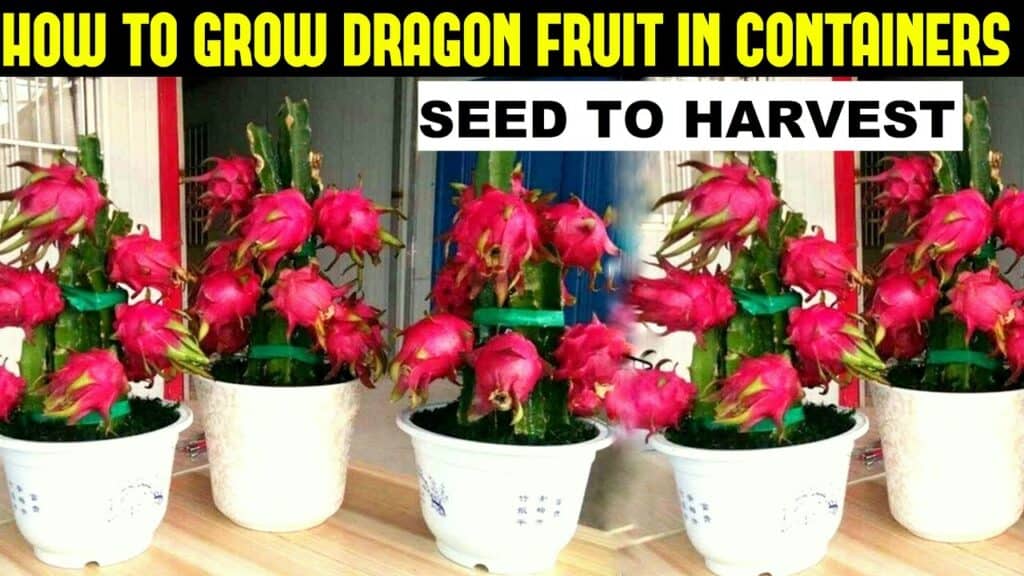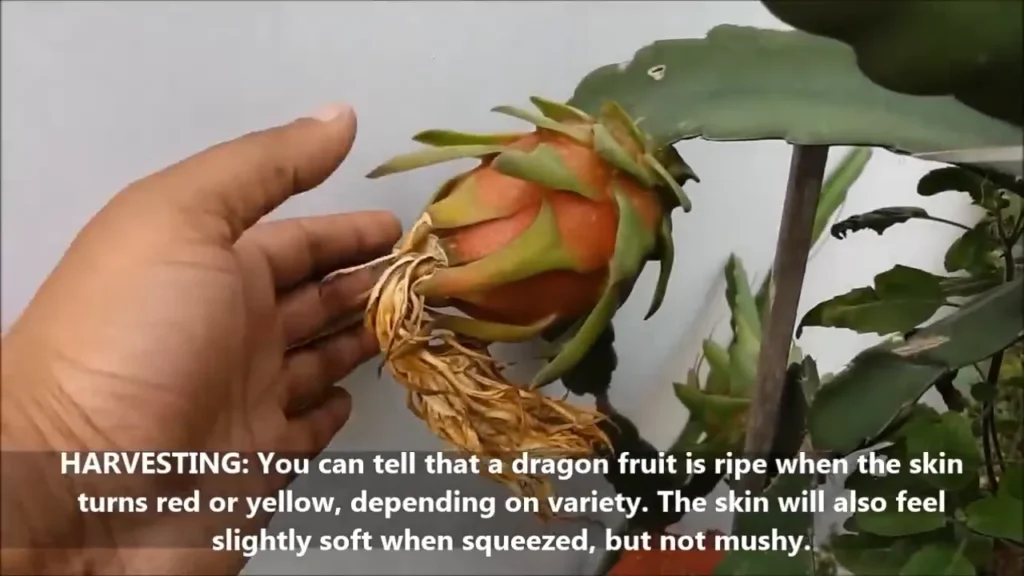
Is your bag packed for the skillful journey? Through this manual, we will unravel the technique of planting and growing dragon fruit, a rare and exotic fruit that can easily be grown in pots or containers. After you have the proper methods, time and proper techniques, you will be harvesting your own sweet dragon fruit!
Table of Contents
- Introduction to Dragon Fruit
- Why Choose Dragon Fruit?
- Preparing to Grow Dragon Fruit
- Selecting the Right Container
- Soil and Compost Mixture
- Planting the Cuttings
- Watering and Care
- Understanding Flowering and Pollination
- Common Challenges in Growing Dragon Fruit
- Harvesting Your Dragon Fruit
- Varieties of Dragon Fruit
- FAQs About Growing Dragon Fruit
Introduction to Dragon Fruit
Pitaya, or dragon fruit, is a uncommon fruit that is very beautiful and is favored with its colors and oddity. The beauty of it as a mutant imaginative creature with pink or yellow skin instead of the typical one, and green-tipped scales on the body, makes it one of the top choices for both gardeners and fruit lovers. Apart from being beautiful, dragon fruit is also a superfood with a range of health benefits and its sweet delightful taste can be an asset to any dish.
The formidable tropical fruit is the top standard of container gardening that it can grow optimally in any environmental surrounding. Besides, fruiting it is one of the best rewarding experiences in your gardening journey whether you are modeling yourself as an expert or a novice; this will enable you to be an owner of fresh fruits of your own right in your backyard or balcony.
Why Choose Dragon Fruit?
The selection of dragon fruit as a horticultural subject has several benefits. Below are some of the main reasons why this fruit needs to be on the list of things to plant in your garden:
- Health Benefits: Dragon fruit is rich in vitamins, antioxidants, and fiber, promoting overall health.
- Unique Flavor: The taste is mildly sweet with a hint of tartness, making it a versatile ingredient in smoothies, salads, and desserts.
- Attractive Plant: The plant itself is visually stunning, with climbing vines and beautiful flowers that bloom at night.
- Low Maintenance: Once established, dragon fruit plants require minimal care and are drought-tolerant, making them ideal for busy gardeners.
Preparing to Grow Dragon Fruit
Prior to planting your dragon fruit cuttings, the most important aspect is the proper setting of the growing environment. This action defines the place for the strong growth and fruit to be produced.
To start, you need to find a spot that gets plenty of sunshine and stays sunny for at least 6-8 hours every day. Dragon fruit grows best in warm conditions which are preferably between 65°F and 85°F (18°C and 29°C). If your region experiences lower temperatures, it is worth considering putting your pots or containers close to a wall or any structure that can retain some heat.
Selecting the Right Container
Choosing the right pot is crucial for effectively growing dragon fruit. Here are some suggestions to aid you in selecting:
- Size: Select a container that is at least 18 inches deep and 12 inches wide. This allows ample space for root development.
- Material: Choose a pot made of breathable materials like clay or terracotta to prevent root rot.
- Drainage: Ensure your container has drainage holes to allow excess water to escape, which is crucial for healthy root growth.
Soil and Compost Mixture
Dragon fruit thrives best in a soil mixture that has excellent drainage while having the ability to retain moisture and not becoming waterlogged. This is the method of preparing the ideal soil mixture:
- Base Mix: Use a commercial cactus mix or create your own by combining equal parts of potting soil, sand, and perlite.
- Organic Matter: Incorporate organic compost to provide essential nutrients. A mix of compost and worm castings works wonders.
- pH Level: Aim for a soil pH between 6.0 to 7.0 for optimal growth.
Planting the Cuttings
Now you have the container and soil prepared; it’s time to plant your dragon fruit cuttings. Just carry out the following phases to enable successful planting:
- Prepare the Cuttings: Use healthy, mature cuttings that are at least 8-12 inches long. Allow the cut ends to dry for a couple of days to form a callus.
- Planting: Dig a hole in the center of your container, place the cutting upright, and cover it with soil, leaving the top exposed.
- Watering: Water the newly planted cutting lightly to settle the soil around it. Avoid overwatering, as this can lead to rot.

Watering and Care
Sometimes, watering dragon fruit needs to be done correctly to promote its growth. The plant is made to live in a wet but not soggy environment, therefore watering must be done enough but not overly. Go for watering your dragon fruit once in 1-2 weeks and take care that the soil dries completely before the following watering.
Hot weather may prompt you to water your plants more often. Always check the moisture in the soil as a first step; if the upper inch feels dry, that indicates it’s time to water. Remember to be careful during the rainy season as you might end up with waterlogged conditions.
Understanding Flowering and Pollination
The crop of dragon fruit is accompanied by the growing of spectacular night-blooming flowers that are visited by dark-flying insects during the night.. The white flowers have a rather big size, and they give out a pleasant smell, thus, they are easily perceived as the most attractive flowers in the garden, even if actually, they open only for a night. It is worth mentioning the importance of pollination to the fruit setting; to visualize this fact let’s make a comparison where a fresh crop of dragon fruit depends on the know-how of a pollinator. In fact, deciduous fruit tree with an understanding of their relationship. Why not think of those plants as partners that not only bear fruit together but also experience the benefits of their association?
In case of low natural pollinators, for instance, bees, the best way to make sure that the plants are successfully pollinated is through hand pollination of flowers. Taking a small brush, you can collect the pollen from the male flower and then, you can apply it to the female. Via this method, you can elevate your success rate on the yield significantly.

Common Challenges in Growing Dragon Fruit
Similar to other flora, cultivating dragon fruit entails encountering certain problems. You should be aware of the following challenges that you could encounter:
- Pests: Watch for pests like aphids and mealybugs. Regularly inspect your plants and use insecticidal soap if necessary.
- Diseases: Fungal infections can occur in humid conditions. Ensure proper airflow around your plants and avoid overhead watering.
- Temperature Sensitivity: Dragon fruit prefers warm conditions. Protect your plants from frost, as cold temperatures can damage them.
Harvesting Your Dragon Fruit
Dragon fruit harvesting is a thrilling stage! You will realize that it is the perfect time for harvesting the fruit whenever its shell becomes a vivid color, for the most part, bright pink or yellow, depending on the type. The spines or scales on the fruit need to flat too, this will be the sign of ripe fruit.
Utilize a pointed blade to sever the fruit off the plant, Husk short stem present to prevent it from being injured. A newly picked dragon fruit is for firsthand tasting or it can be stored in the fridge for a couple of days.

Varieties of Dragon Fruit
There are a lot of dragon fruit types, and every one of them has distinct features. Presently, there are a few varieties you can choose to cultivate that are well known:
- Hylocereus undatus: Known for its white flesh and pink skin, this is the most common variety.
- Hylocereus costaricensis: This variety features red flesh and a slightly sweeter flavor.
- Hylocereus megalanthus: Also known as yellow dragon fruit, it has white flesh and a unique taste.

FAQs About Growing Dragon Fruit
The following questions are some of the most commonly asked by individuals seeking to comprehend the appropriate cultivation of dragon fruit or people who want to be familiar with thedragon fruit farming process:
- How long does it take for dragon fruit to fruit? Generally, it takes about 1-3 years from planting to harvest, depending on the growing conditions.
- Can dragon fruit be grown indoors? Yes, as long as they receive adequate sunlight and are kept in a warm environment.
- What should I do if my dragon fruit isn’t flowering? Ensure your plant receives enough sunlight, and consider hand-pollination for better results.
Related Articles: How To Grow Strawberries From Seed: A Step-by-Step Guide , How To Grow Chillies At Home: A Comprehensive Guide from Seed To Harvest


Pingback: How To Grow Strawberries From Seed: A Step-by-Step Guide - Vidz ni Rye
Pingback: How To Grow Chillies At Home: A Comprehensive Guide from Seed To Harvest - Vidz ni Rye
Pingback: How to Grow Tomatoes: A Beginner's Guide to a Bountiful Harvest - Vidz ni Rye